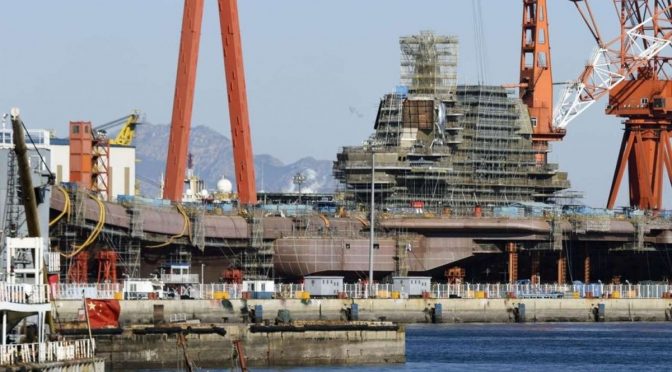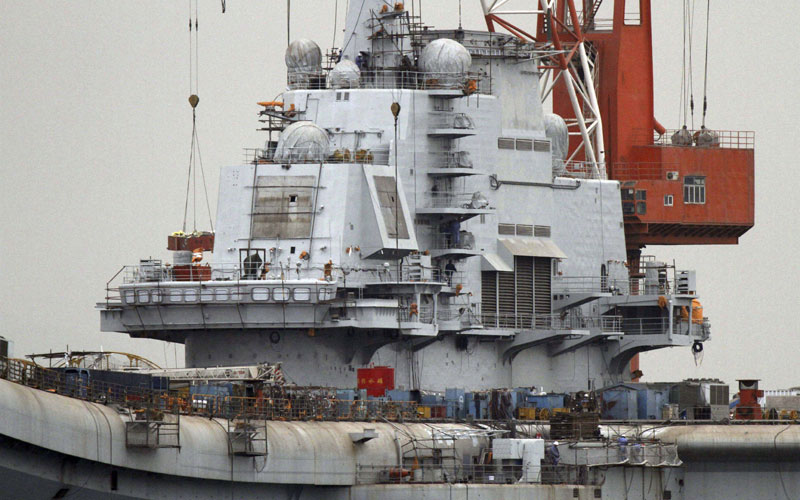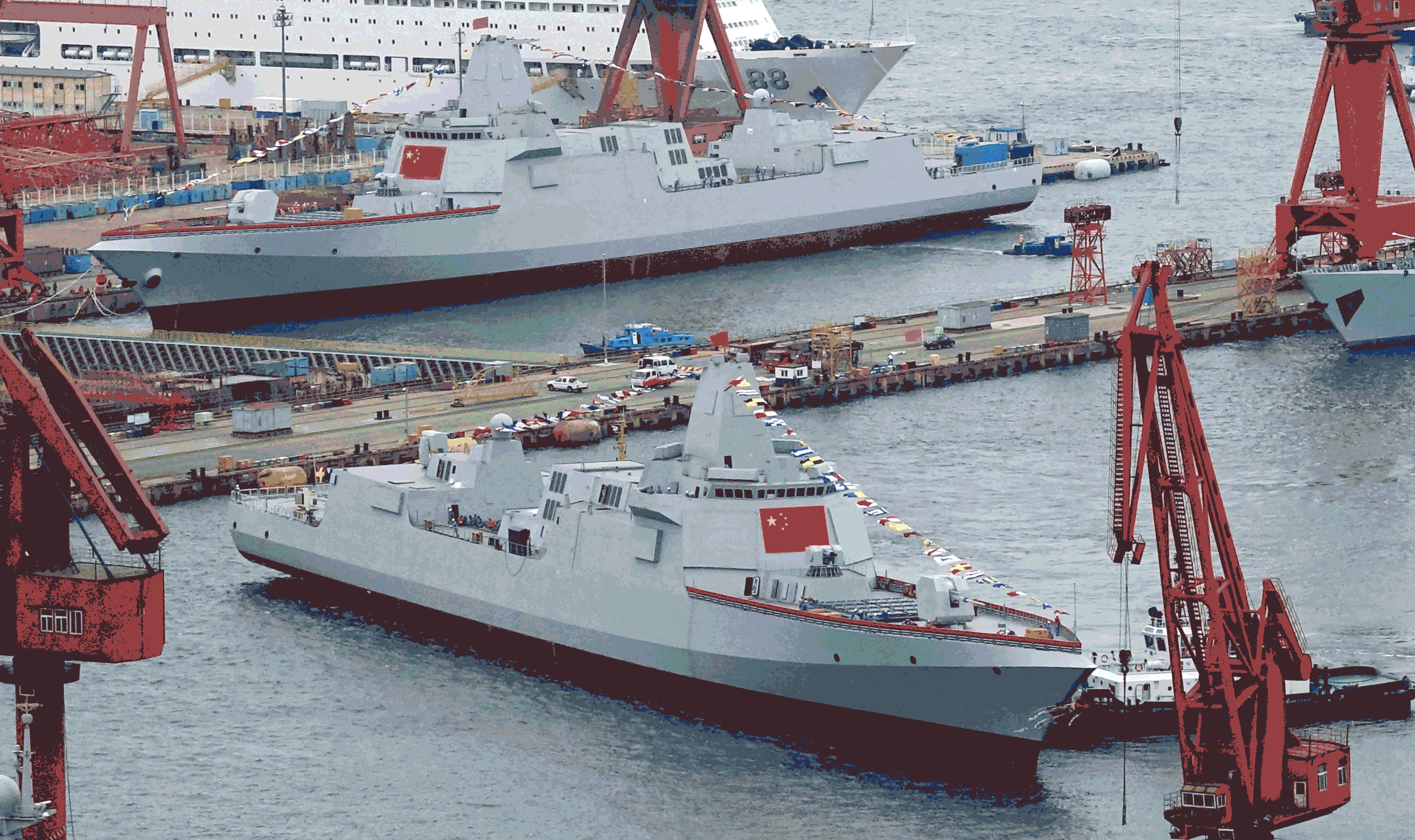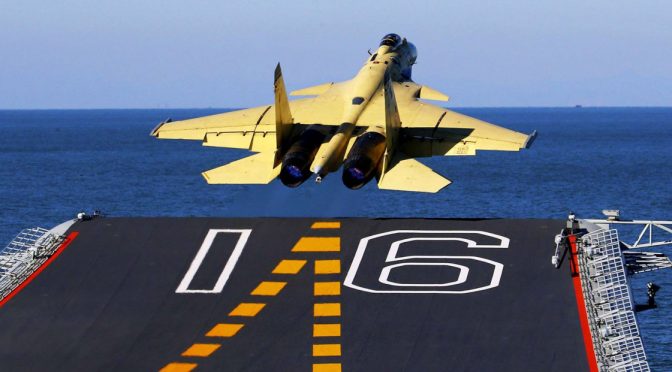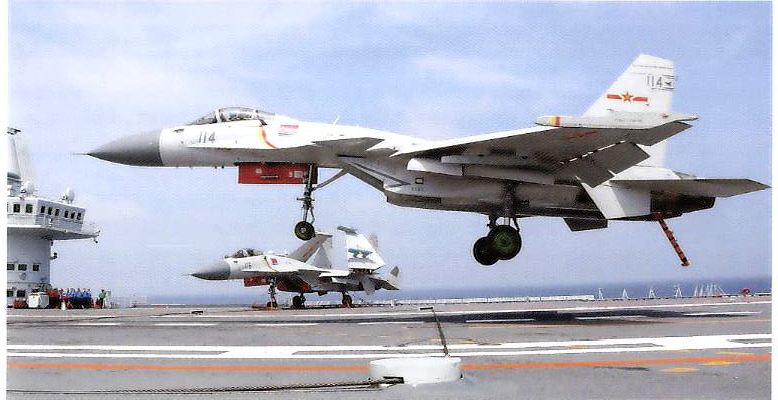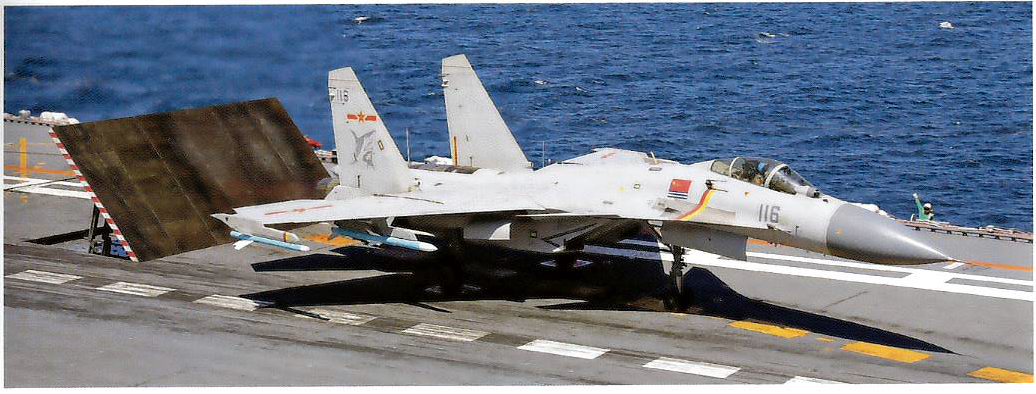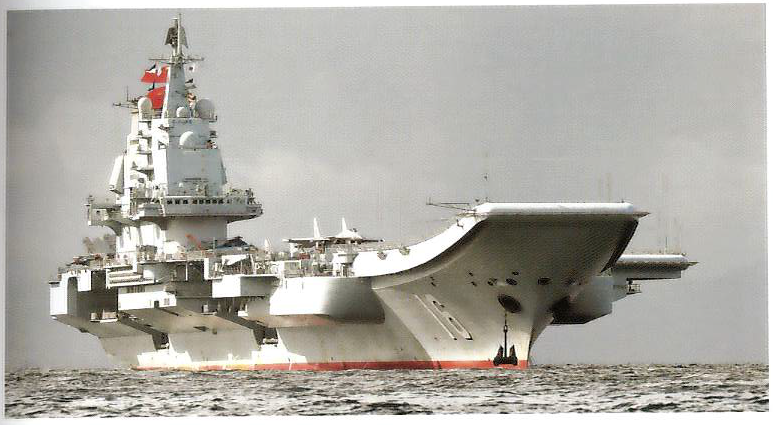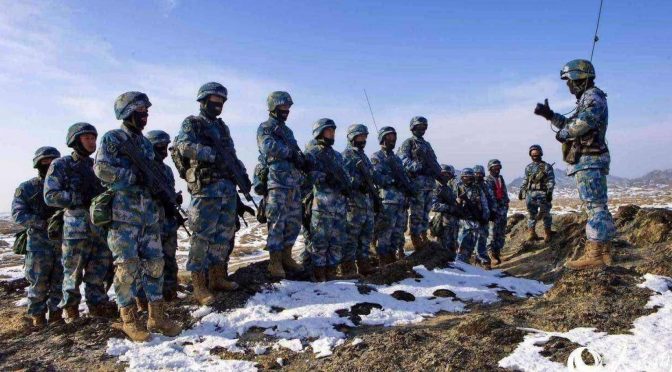By Ryan D. Martinson
Every year, about this time, the leaders of the People’s Liberation Army Navy (PLAN) send their regards to Chinese sailors deployed overseas during the Lunar New Year. Every year these messages are covered by the Chinese press. Few in China pay attention to these reports. Fewer foreign observers even know of them, but they should. This annual ritual tells the story of China’s emergence as a global naval power.
A Tradition is Born
PLAN leaders made their first Lunar New Year’s call in the second year of China’s anti-piracy escort mission in the Gulf of Aden. On the afternoon of February 11, 2010 PLAN Commander Wu Shengli and Political Commissar Liu Xiaojiang met in the PLAN Operations Command Center. There they held a video teleconference (VTC) with the members of China’s 4th escort task force. According to Chinese press reports, the two leaders expressed their “holiday wishes” and “enthusiastic regards” to all Chinese sailors who were “fighting on the frontlines” in China’s anti-piracy mission.1
This VTC established the pattern for future lunar salutations. Admiral Wu praised the sailors for all that they had achieved while abroad. After 105 days, they had escorted 359 commercial ships, rescuing three from pirate attack. In doing their duty, they had portrayed an image of China as a responsible great power and “won wide acclaim both at home and abroad.” Wu entreated his sailors to faithfully implement the policies and instructions of the Central Military Commission and its Chairman, Hu Jintao. He warned them against complacence—they can and should strive to do better. Liu Xiaojiang followed with more praise, and orders for the task force commander to arrange fun activities so that sailors could have a safe, auspicious, and happy Spring Festival.2
During the two years that followed, only the anti-piracy mission kept Chinese sailors in the “far seas” (远海) during the Lunar New Year.3 From their station off the Horn of Africa, these forces helped protect Chinese commercial vessels and personnel transiting the Gulf of Aden. They also performed other non-combat operations, such as evacuating Chinese citizens from Yemen in 2015. Meanwhile, the Chinese Navy was developing another far seas mission set—high-intensity combat operations east of the first island chain. In 2013, this objective brought Chinese sailors to sea on the most important holiday of the year.
Year of the Snake (2013)
On February 6, 2013, Wu Shengli and Liu Xiaojiang held two VTCs—a first in the history of New Year’s salutations. They called Task Force 570, which was conducting escort operations in the Gulf of Aden, China’s 13th escort task force to date. For their second call, they connected with Task Force 113, then doing far seas training in the Philippine Sea. It comprised three vessels from the North Sea Fleet: the destroyer Qingdao and two frigates, the Yantai and Yancheng.4
Deployments to the Philippine Sea were not unusual. The PLAN routinized operations east of the first island chain in 2007. Task Force 113 represented just one of six (or more) far seas deployments in 2013, and it was certainly not the biggest. Indeed, in October of that year elements of all three PLAN fleets—North, East, and South—congregated in the Philippine Sea for MANEUVER-5, the PLAN’s first large-scale confrontation exercise in the far seas. But Task Force 113 was the first to conduct far seas training during the Spring Festival. With this decision, Wu and Liu showed that China was serious about its plans to transform the PLAN into a force capable of conducting high-intensity operations east of the first island chain, against the only potential adversary that could conceivably be there—the U.S. Navy.5 The years since have seen a dramatic acceleration in the pace of this transformation.
Year of the Horse (2014)
As Chinese citizens prepared to celebrate the year of the horse, hundreds of PLAN personnel were abroad. Wu and Liu made two calls on January 27, 2014. Aside from the 16th escort task force, they talked to Task Force 989, then pioneering a new model for far seas training.6 Up until then, PLAN far seas training mostly involved forays into the Philippine Sea. Task Force 989 conducted the PLAN’s first “two-ocean” (两洋) deployment. The task force—which comprised three surface combatants from the South Sea Fleet—departed Sanya, Hainan on January 20th.7 It sailed through the South China Sea, where it drilled with China’s submarine force, sharpening skills and tactics needed to break an enemy blockade. After that, the task force continued south, lingering at the James Shoal to hold a ceremony marking the southernmost extent of claimed Chinese territory. It then sailed through the Sunda Strait, into the Indian Ocean. After training in waters south of Java, the three ships next proceeded north into the western Pacific via the Lombok Strait, Makassar Strait, and Celebes Sea. After operating in the Philippine Sea, Task Force 989 crossed the first island chain at the Miyako Strait, before heading home to Zhanjiang, Guangdong, where it arrived on February 11th. During its 23-day deployment, the task force conducted “realistic” (实战化) training along the strategically-important waterways connecting the Pacific Ocean and Indian Ocean.8

Year of the Goat (2015) and Year of the Monkey (2016)
The years 2015 and 2016 saw increased emphasis on noncombat operations in the far seas. In the past, anti-piracy escort task forces relieved before the Lunar New Year always arrived home before the holiday. This changed in the year of the goat. When Admiral Wu and the new PLAN Political Commissar, Miao Hua, called the navy’s overseas forces on February 15, 2014, Task force 547 was on its third month of escort operations in the Gulf of Aden.9 Meanwhile, the 18th escort task force was then in Piraeus, Greece, on a four-day port visit.10 It would not arrive home until March 19, 2015. Wu and Miao also connected with Task Force 138, led by the East Sea Fleet’s Sovremenny-class destroyer Taizhou, which spent the Lunar New Year training in the Philippine Sea.
The year of the monkey looked much the same. When Wu and Miao called on the afternoon of February 2nd, they spoke to three different PLAN task forces operating abroad. Task Force 57, the 21st escort task force, was then just pulling into India to participate in an international fleet review. Its relief, Task Force 576, was conducting anti-piracy operations off the Horn of Africa. Meanwhile, a task force led by the North Sea Fleet’s destroyer Harbin was deployed somewhere in the Western Pacific.11
Year of the Rooster (2017)
No PLAN surface forces operated east of the first island chain during the 2017 Lunar New Year—at least none that Beijing cared to admit.12 The PLAN’s new Commander, Vice Admiral Shen Jinlong, and Political Commissar Miao Hua made the annual New Year’s call on the morning of January 20, 2017. They spoke to two escort task forces: the 24th (then preparing to arrive in Qatar), and the 25th (on station off the Horn of Africa).13 Shen and Miao inaugurated a new tradition on this day. They held a VTC with PLAN personnel involved in the construction of China’s massive new military bases in the disputed Spratly Islands. In his remarks, Shen described them as operating “on the front lines of island/reef construction.” He praised the sailors for “resolutely implementing Chairman Xi’s policy” and achieving the “strategic aims” (战略目标) of the new construction, which he did not define.
Why did Shen and Miao conduct a VTC with sailors in the Spratly Islands in 2017, when PLAN personnel had been there since the 1980s? Why only the Spratlys, not the Paracel Islands, which were also in the midst of a construction boom, or naval forces operating along other parts of China’s maritime frontier? This decision suggests that PLAN leaders regarded the new Spratly bases as more than just installations with which to influence events in the South China Sea, but also as key components of the Navy’s far seas force structure.
Year of the Dog (2018)
On the afternoon of February 12, 2018, PLAN leaders held four VTCs—more than ever before.14 Vice Admiral Shen Jinlong and new Political Commissar Qin Shengxiang talked to the 28th escort task force, which had just completed an escort mission to Kenya. They also called Task Force 173, then in the eastern Indian Ocean conducting a “two ocean” deployment.15 This task force comprised four ships from the South Sea Fleet—the destroyer Changsha, frigate Hengyang, LPD Jinggangshan, and supply ship Luomahu. After the call, it would sail north into the Philippine Sea, disappointing widespread media speculation that it might head to the Maldives during the climax of that country’s political crisis. Task Force 173 arrived home on February 25, 2018.
Shen and Qin also called PLAN sailors stationed at China’s first overseas military base. According to Chinese reporting, Shen praised the sailors for “blazing the path for overseas base construction,” clearly indicating that while Djibouti may be the first, it would not be the last. Shen and Qin also called Chinese sailors stationed in the Spratly Islands, which they now called the “Spratly Garrison” (南沙守备部队). Shen thanked them for “their important contributions to guarding and constructing the Spratlys.”16
Shen and Qin made four calls on that day; but they should have made a fifth. Chinese reporting on the VTC excludes any mention of Task Force 171 (i.e., the 27th escort task force). It comprised three vessels—the destroyer Haikou, the frigate Yueyang, and the supply ship Qinghaihu. In the second half of January 2018, after making port visits to Tunisia and Algeria, Task Force 171 passed through the Strait of Gibraltar before navigating south along the west coast of Africa. On February 7th, the warships held anti-piracy exercises somewhere in the Gulf of Guinea.17 Reporting on Task Force 171 then went quiet for 12 days, until February 19, when the ships arrived in Cape Town, South Africa, for a two-day port visit. This timeline indicates that when Shen and Qin made their calls on February 12, Task Force 171 was somewhere in the South Atlantic.
Shen and Qin almost certainly called Task Force 171—why would they exclude them? But if so, why choose not to publicize the call? There is no clear answer. Was the mere presence of the task force in the Atlantic judged too sensitive? Unlikely, since this was not the first time that PLAN ships had been there. Just six months earlier, Task Force 174 took the long way home from the Baltic, where it had held exercises with the Russian Navy.18 In mid-August 2017, it conducted simulated “missile attack exercises” somewhere in the Atlantic.19 But its activities were only publicized in the PLAN press, not the wider media, as New Year’s salutations always are. Perhaps the problem was that allowing press coverage of the VTC would require that PLAN leaders publicly explain what the task force was doing in the Atlantic, and why.
Year of the Pig (2019)
February 2, 2019 was a very busy day at the PLAN Operations Command Center. On the eve of the lunar holiday, Shen Jinlong and Qin Shengxiang called five different Chinese task forces operating abroad. Only one anti-piracy escort task force was on their list—the 31st. The 30th escort task force had arrived in Qingdao on January 27, just in time to celebrate the Lunar New Year. As in 2018, Shen and Qin called the Spratly Garrison and the PLAN’s base in Djibouti. However, for the first time in PLAN history, two task forces conducted far seas training deployments during the Spring Festival. The first comprised a task force led by the East Sea Fleet destroyer Zhengzhou. Chinese press coverage did not indicate where Task Force 151 was, or what it was doing.
The Chinese media did cover the movements of the other far seas training task force then at sea. Task Force 174 left Zhanjiang, Guangdong on January 16. It comprised the destroyer Hefei, frigate Yuncheng, LPD Changbaishan, and supply ship Honghu. When Shen and Qin contacted them, they were not in the Philippine Sea, but somewhere in the Central Pacific—that is, somewhere in the vast expanse of ocean between Guam and Hawaii.
Also new, the Chinese press described Task Force 174 as a “far seas joint training task force” (远海联合训练编队). It was working in conjunction with other services under the Southern Theater Command—the PLA Air Force, PLA Rocket Force, and the PLA Strategic Support Force. Official Chinese media sources revealed that one of their aims was to “explore methods and approaches for building joint operations combat capabilities to win modern war at sea.”
Conclusion
The information shared in the PLAN’s annual New Year’s greetings does not account for everything the service is doing abroad. The case of Task Force 171 proves that. These short news reports tell us nothing about the expansion of Chinese submarine operations into the Indian Ocean. Nor do they acknowledge other naval activities best kept secret, such as intelligence collection and hydrographic surveys.
Still, the short history of China’s Lunar New Year’s deployments tells us much about the key events in China’s rise as a global naval power. This history shows a growing emphasis on both the combat and non-combat elements of China’s far seas naval strategy. It highlights the geographic expansion of China’s overseas deployments—where once Chinese ships were concentrated in the northwest Indian Ocean and the Philippine Sea, they now operate as far away as the Atlantic Ocean and the Central Pacific.
In the year of the snake, China’s far seas force structure comprised small task forces largely reliant on at-sea replenishment and the expensive hospitality of foreign ports. In the year of the pig, it included significant shore-based infrastructure, including the country’s first—but not last—overseas military base in Djibouti and colossal new installations in the Spratly Islands. This chronicle of the PLAN’s New Year’s deployments also shows how China’s growing emphasis on jointness is affecting naval operations abroad, and informing Beijing’s preparations for high-end conflict at sea. All of these things have happened in a single decade.
This history is far from over. By all accounts, the Chinese Navy has a long way to go before fully realizing its nautical ambitions. Xi Jinping has told the PLAN to set its sights on becoming a “world-class navy” by mid-century. What that means is impossible to tell. The PLAN has not shared its benchmarks for success. What is clear is that the decisions of PLAN commanders on the eve of each Lunar New Year will continue to serve as a useful gauge for progress in this journey, wherever it ends up.
Ryan D. Martinson is a researcher in the China Maritime Studies Institute at the U.S. Naval War College. The views expressed are those of the author and do not reflect the official policy or position of the U.S. Navy, Department of Defense or the U.S. Government.
References
1. 袁珍军 [Yuan Zhenjun] 海军首长视频慰问525编队全体官兵 [“Head of the Navy Holds a Video-Teleconference to Send Regards to All Officers and Enlisted of Task Force 525”] 人民海军 [People’s Navy] February 12, 2010, p. 1.
2. Ibid
3. In Chinese military discourse, the term “near seas” (近海) refers to the Bohai Gulf, Yellow Sea, East China Sea, and South China Sea. The term “far seas” refers to all waters beyond the near seas.
4. 蒲海洋 [Pu Haiyang] 海军首长视频慰问570,113 编队官兵 [“Head of Navy Holds Video-Teleconference to Send Regards to the Officers and Enlisted of Task Force 570 and Task Force 113”] 人民海军 [People’s Navy] February 8, 2013, p. 1.
5. During the VTC, Admiral Wu told the sailors that their sacrifice “held important significance for strengthening the concept of readiness embodied in the phrase ‘being able to fight and win’ exploring and putting into practice a mechanism for normalizing far seas training, exercising and improving the service’s ability to conduct far seas missions and tasks, and realizing a good start to the surface fleet’s annual far seas training.” See Pu Haiyang, “Head of Navy Holds Video-Teleconference,” op. cit.
6. 梁庆松 [Liang Qingsong] 海军首长视频慰问546,989编队官兵 [“Head of Navy Holds Video-Teleconference to Send Regards to the Officers and Enlisted of Task Force 546 and Task Force 989”] 人民海军 [People’s Navy] January 28, 2014, p. 1.
7. The task force included the LPD Changbaishan, the destroyer Haikou and the destroyer Wuhan.
8. 高毅 [Gao Yi], 南海舰队远海训练编队返港, 海军副政委王森泰到码头迎接并讲话 [“Far Seas Training Task Force from the South Sea Fleet Returns to Port, Deputy Political Commissar of the Navy Wang Sentai Meets Them Pier Side and Gives a Speech”], 人民海军 [People’s Navy], February 12, 2014, p. 1.
9. 王元元 [Wang Yuanyuan] 海军首长视频慰问547,138编队 [“Head of Navy Holds Video-Teleconference to Send Regards to the Officers and Enlisted of Task Force 547 and Task Force 138”] 人民海军 [People’s Navy] February 16, 2015, p. 1.
10. The task force was in Greece from February 16-20, 2015. Perhaps because the crew were too busy ashore, Wu and Miao sent their New Year’s salutations via written message. See Wang Yuayuan, “Head of Navy Holds Video-Teleconference,” op. cit.
11. 王元元 [Wang Yuanyuan] 海军首长视频慰问海上任务编队 [“Head of Navy Holds Video-Teleconference to Send Regards to Task Forces at Sea”] 人民海军 [People’s Navy] February 2, 2016, p. 1.
12. A task force departed Sanya, Hainan for a “two-ocean” training deployment on February 10, just after the holiday ended.
13. 梁庆松 [Liang Qingsong] 海军首长视频慰问112,568编队和岛礁建设部队官兵 [“Head of Navy Holds Video-Teleconference to Send Regards to Officers and Enlisted from Task Force 112, Task Force 568, and Island/Reef Construction Unit”] 人民海军 [People’s Navy] January 23, 2017, p. 1.
14. 王元元 [Wang Yuanyuan] 海军领导视频慰问海上任务编队,驻南沙岛礁和海外保障基地官兵 [“Navy Leaders Hold Video-Teleconference to Send Regards to Sailors from Task Forces at Sea, Located at Spratly Islands/Reefs, and Overseas Support Base”] 人民海军 [People’s Navy] February 13, 2018, p. 1.
15. The People’s Navy newspaper reports that on February 13, 2018 the task force was operating in the eastern part of the Indian Ocean, doing an anti-piracy exercise. See 周启青 [Zhou Qiqing] 大洋深处的”飓风营救” [“A ‘Hurricane Rescue’ in the Depths of the Ocean”] 人民海军 [People’s Navy] February 26, 2018, p. 1.
16. Wang Yuanyuan, “Navy Leaders Hold Video-Teleconference,” op. cit.
17. 刘鑫 [Liu Xin] 我护航编队几内亚湾组织机动巡航训练 [“Navy Escort Task Force Holds Maneuver Patrol Training in the Gulf of Guinea”] 人民海军 [People’s Navy] February 12, 2018, p. 1.
18. Task Force 174 comprised the Type 052D destroyer Hefei, Type 054A frigate Yuncheng, and supply ship Luomahu.
19. 梁庆松 [Liang Qingsong] 砺兵,万里航程真如铁—174舰艇编队远海大洋实战化练兵纪事 [“Grinding the Sailors, A Long Journey is Just Like Iron—A Chronicle of Task Force 174’s Realistic Far Seas Training”] 人民海军 [People’s Navy] September 27, 2017, p. 1.
Featured Image: Leading by the amphibious dock landing ship Kunlunshan (Hull 998), vessels attached to a landing ship flotilla with the South China Sea Fleet under the PLA Navy steam in formation during the maritime live-fire training in waters of the South China Sea from January 17 to 19, 2018. (eng.chinamil.com.cn/Photo by Liu Jian)


